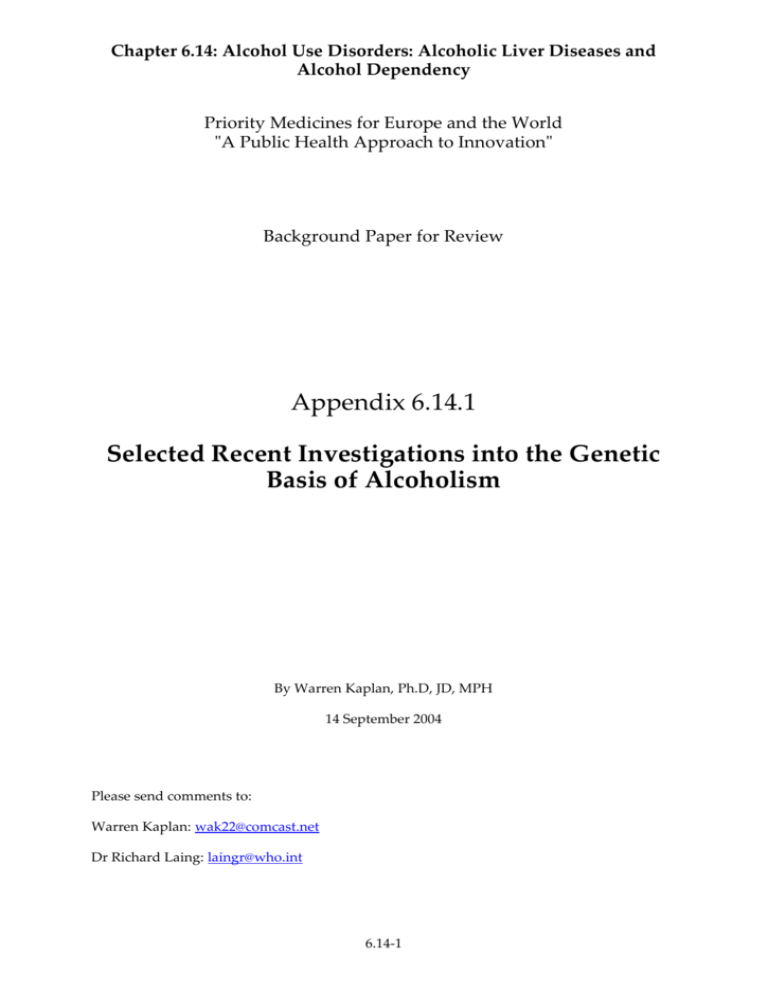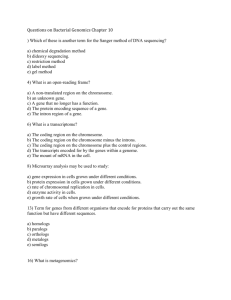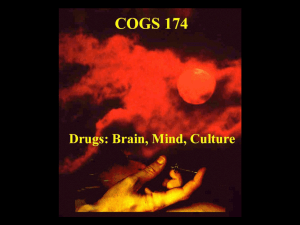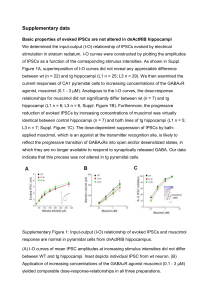Selected Recent Investigations into the Genetic
advertisement

Chapter 6.14: Alcohol Use Disorders: Alcoholic Liver Diseases and Alcohol Dependency Priority Medicines for Europe and the World "A Public Health Approach to Innovation" Background Paper for Review Appendix 6.14.1 Selected Recent Investigations into the Genetic Basis of Alcoholism By Warren Kaplan, Ph.D, JD, MPH 14 September 2004 Please send comments to: Warren Kaplan: wak22@comcast.net Dr Richard Laing: laingr@who.int 6.14-1 Chapter 6.14: Alcohol Use Disorders: Alcoholic Liver Diseases and Alcohol Dependency Authors Year Chromosome/Gene/Allele/SNP Investigated Outcome/Findings Edenberg, H.J., D.M. 2004 GABA(A) receptors (chromosome Dick, X. Xuei, H. Tian, 4p) L. Almassy, L.O. Bauer, et al. A three-SNP haplotype in the region of GABA receptor A2 was associated with alcoholism (p<.0001). 31 single nucleotide changes in the gene for the receptor showed significant association with alcoholism. Limosin, F., J.Y. Loze, 2003 F. Rouillon, J. Ades, P. Gorwood Dopamine D1 receptor gene polymorphism Results suggest a limited association between the dopamine D1 receptor gene polymorphism and sensationseeking score among alcoholdependent men, but not women. 2003 Dopamine D1 receptor (investigated in rats) Dopamine D1 receptor plays a salient role in selectively modulating alcohol-motivated behaviors. 2001 ALDH2, CYP2E1, ADH2, ADH3 Association study fndings suggest that certain ethanol metabolizing enzymes protects against alcoholism, however development of cirrhosis not associated. Chromosome 1, 2, 6, and 16 A gene or genes on chromosome 1 may affect susceptibility to alcoholism and depression (which may be alcohol induced) ALDH2, CYP2E1 Findings strongly suggest that the ALDH2 genotype is strongly associated with alcohol drinking behavior, but the CYP2E1 genotype is not. Alcohol Clin Exp Res. 2003 Aug;27(8):1226-8. Eiler, W.L., R. Seyoum, K.L. Foster, C. Mailey, H.L. June. Synapse. 2003 Apr;48(1):45-56. Lee, H.C., H.S. Lee, S.H. Jung, S.Y. Yi, H.K. Jung, J.H. Yoon, and C.Y. Kim J Korean Med Sci. 2001 Dec;16(6):745-50. Nurnberger, J.I., T. 2001 Foroud, L. Flury, J. Su, E.T. Meyer, K. Hu, R. Crowe, et al. Am J Psychiatry. 2001 May;158(5):718-24 Okamoto. K., Y. Murawaki, A. Yuasa, and H. Kawasaki. 2001 Alcohol Clin Exp Res. 2001 Jun;25(6 Suppl):19S-23S. Loh, E.W., I. Smith, R. 2000 GABAA receptors (chromosome Murray, M. 5q33) McLaughlin, S. McNulty, and D. Ball Mol Psychiatry. 2000 Jul;5(4):452 Lichtermann, D., D. 2000 Hranilovic, M. Trixler, P. Franke, B. Jernej, C.D. Delmo, M. Knapp, S.G. Schwab, W. Maier, D.B. Wildenauer 5-HT serotonin transporter gene (chromosome 17q11.2) 6.14-2 Findings showed associations between alcohol dependence with novel genetic markers at the GABAA alpha2 receptor gene (p=0.015) and the GABAA beta 6 receptor gene (p=0.013). The study findings suggest allelic association between a variant in the promoter region of the serotonin transporter gene and the risk for alcohol dependence (p<0.006). Chapter 6.14: Alcohol Use Disorders: Alcoholic Liver Diseases and Alcohol Dependency Am J Psychiatry. 2000 Dec;157(12):2045-7. Thiele, T.E., B. Willis, J. Stadler, J.G. Reynolds, I.L. Bernstein, G.S. McKnight 2000 cAMP-dependent protein kinase (PKA) RIIalpha subunit (investigated in mice) Study findings demonstrate that the subunit of PKA has a role in regulating voluntary alcohol consumption (p<0.005) and sensitivity to the intoxicating effects of alcohol (p<0.05). 1999 5-HTT, 5-HT2A, 5-HT2C, And GABAA receptor Ü6 (chromosome 5q33) Findings show significant relationships to low-level response to alcohol and alcoholism to the 5HTTLPR serotonin transporter variant (p-0.04) and the GABAA receptor Ü6 (p=0.02). No evidence found for 5-HT polymorphisms (p=0.24, 0.55 and 0.95). Genome scan using 291 markers Analyses provided the strongest suggestions of linkage with susceptibility loci for alcohol dependence on chromosomes 1 and 7, and more modest evidence for a locus on chromosome 2. There was also suggestive evidence for a protective locus on chromosome 4q near the alcohol dehydrogenase genes . CYP2E1 Findings suggest that the CYP2E1 regulatory polymorphism not only enhances CYP2E1 metabolic activity, but it is sufficiently common to impact susceptibility to CYP2E1related diseases in at least two ethnic groups (p<0.01). J Neurosci. 2000 May 15;20(10):RC75 Schuckit, M.A., C. Mazzanti, T.L. Smith, U. Ahmed, M. Radel, N. Iwata, & D. Goldman Biol Psychiatry. 1999 Mar 1;45(5):647-51. Reich, T., H.J. 1998 Edenberg, A. Goate, J.T. Williams, J.P. Rice, P. Van Eerdewegh, T. Foroud, et al. Am J Med Genet. 1998 May 8;81(3):207-15 McCarver, D.G., R. Byun, R.N. Hines, M. Hichme, and W. Wegenek. 1998 Toxicol Appl Pharmacol. 1998 Sep;152(1):276-81. Noble, E.P., X. Zhang, 1998 Dopamine D2 receptor and T. Ritchie, B.R. GABAA receptor alpha3 subunit Lawford, S.C. Grosser, genes R.M. Young & R.S. Sparkes Psychiatry Res. 1998 Nov 16;81(2):133-47. 6.14-3 Variants of the D2 dopamine receptor (p<0.00002) and GABA(A) receptor alpha3 subunit (p<0.03) genes independently contribute to the risk for alcoholism. When the variants are combined, the risk for alcoholism is even greater.









